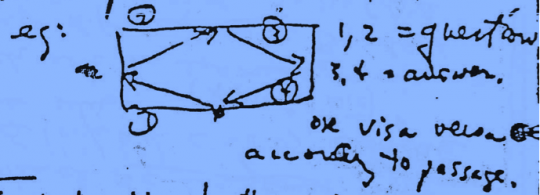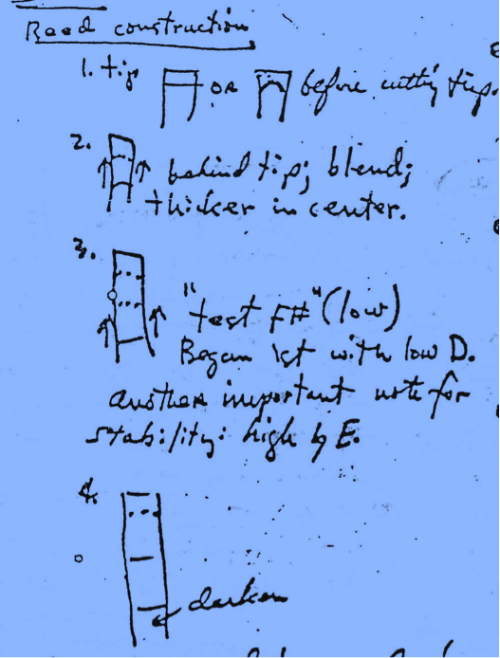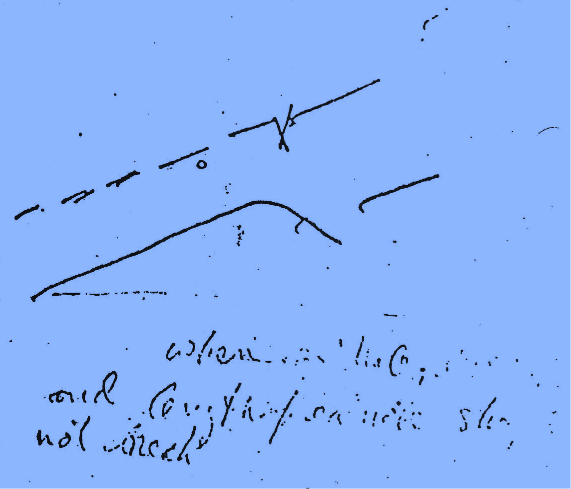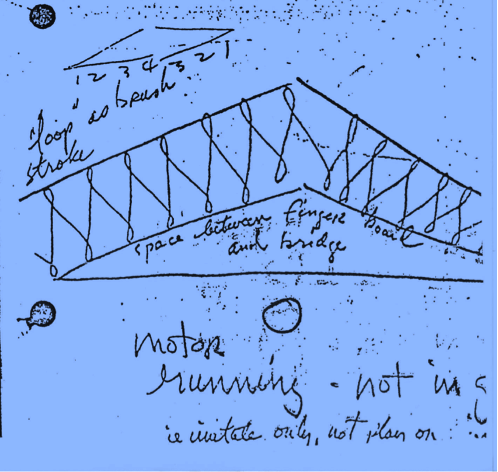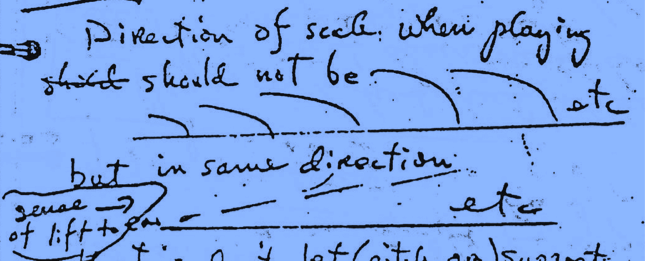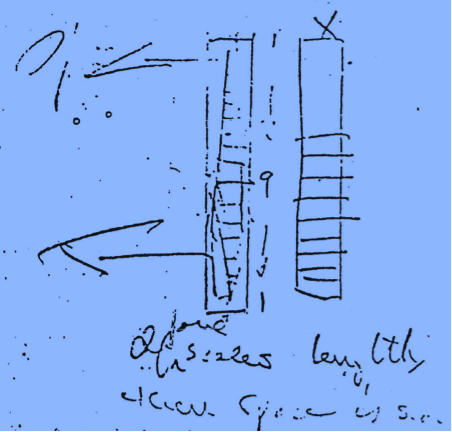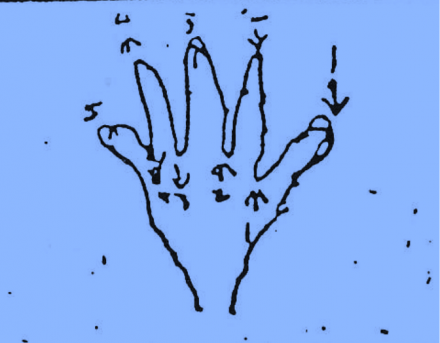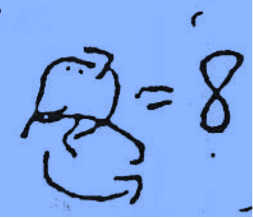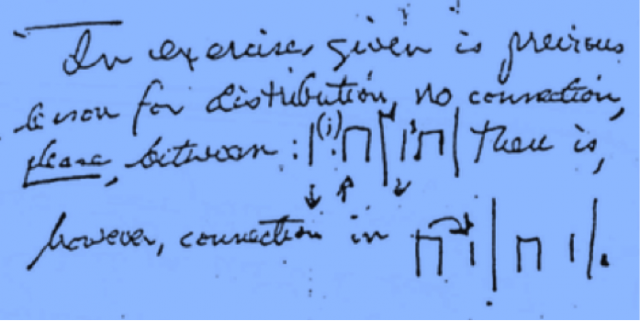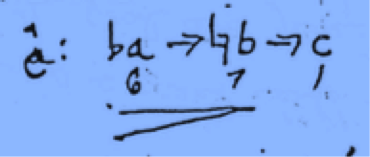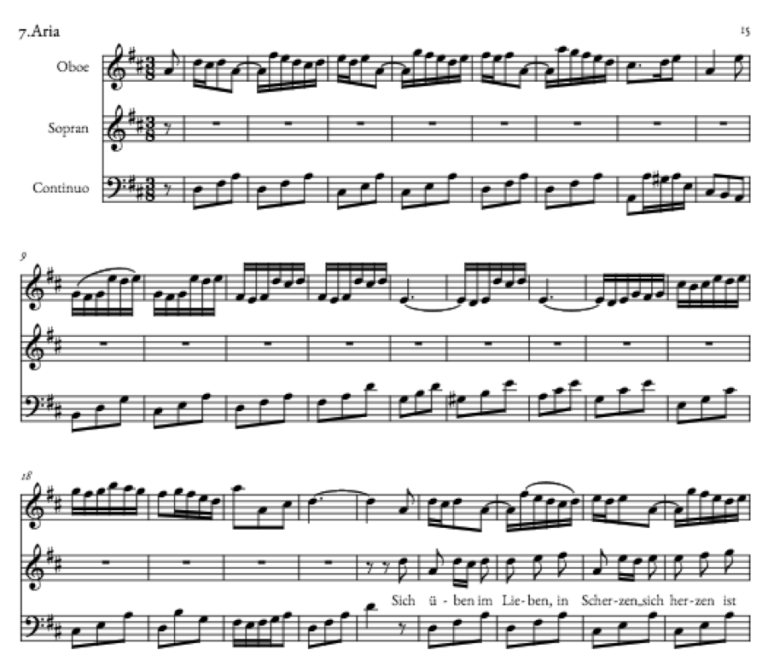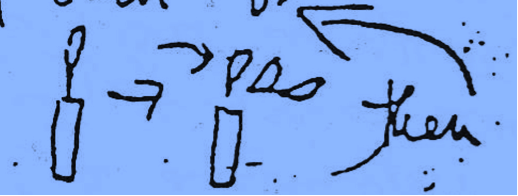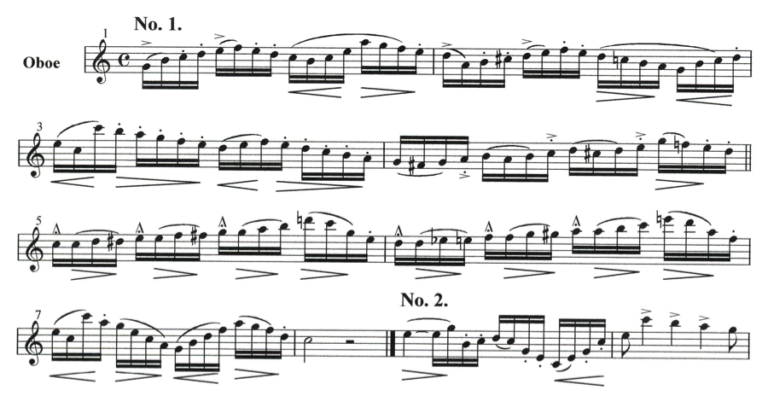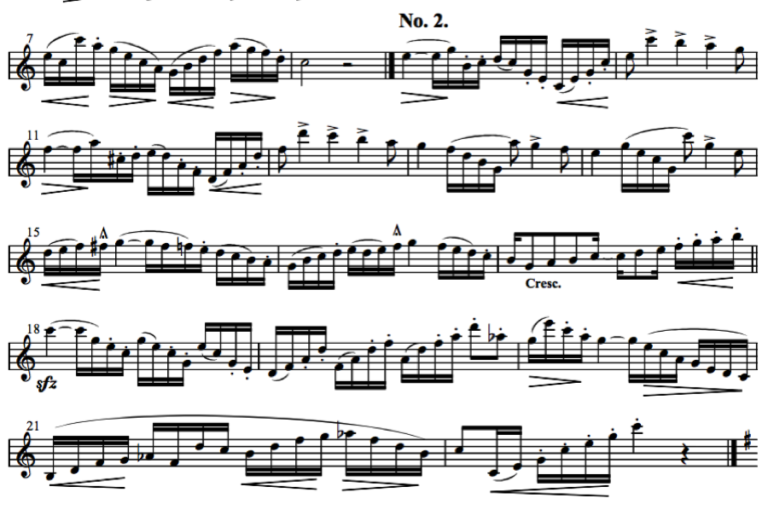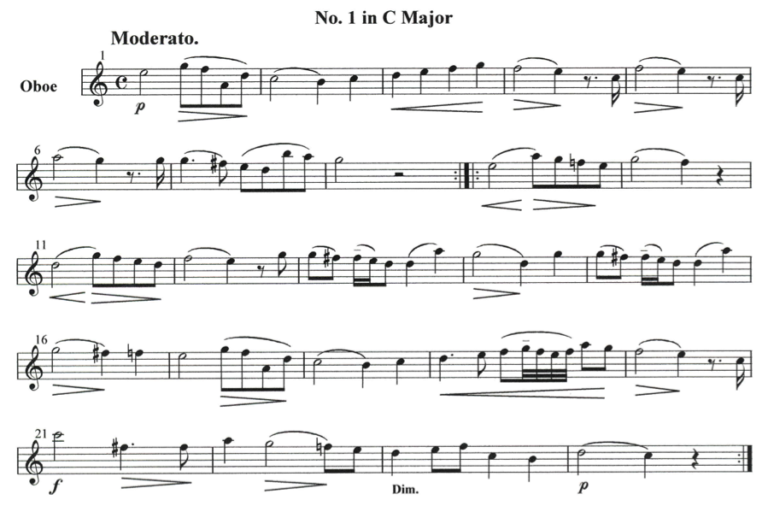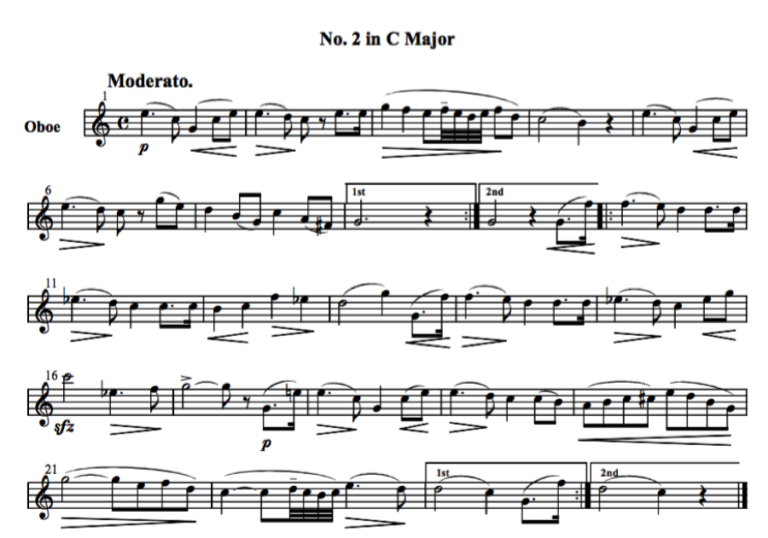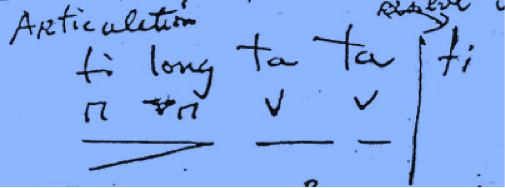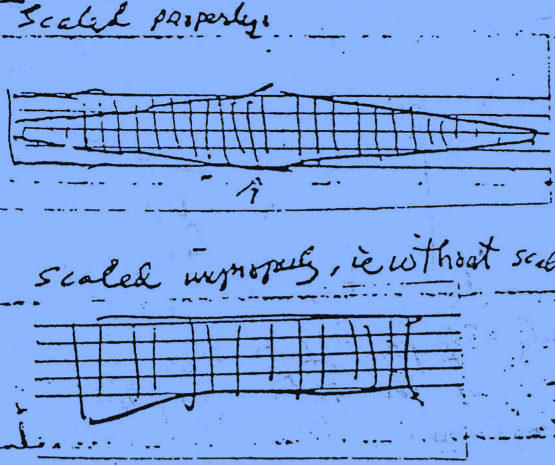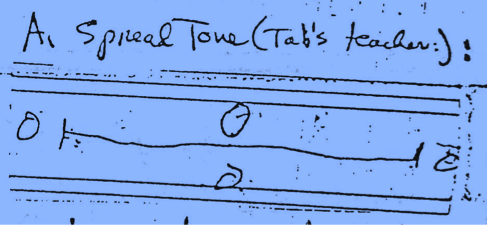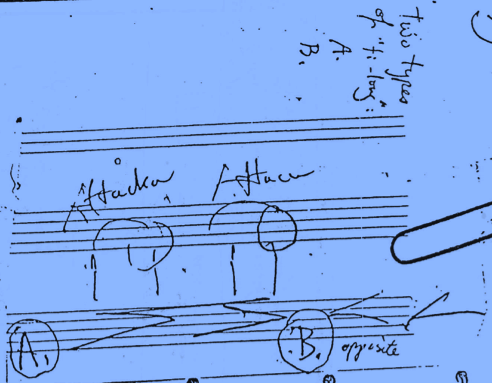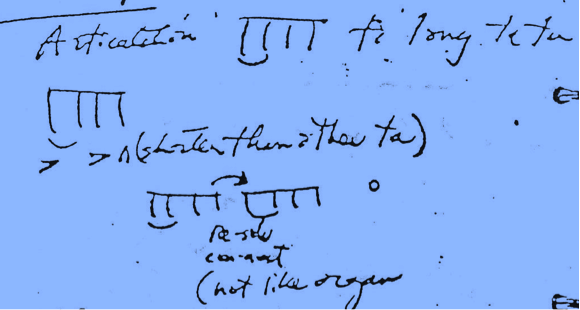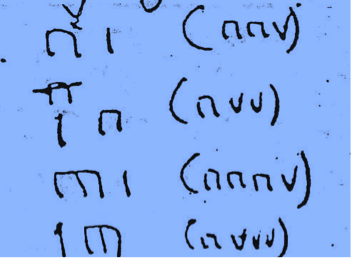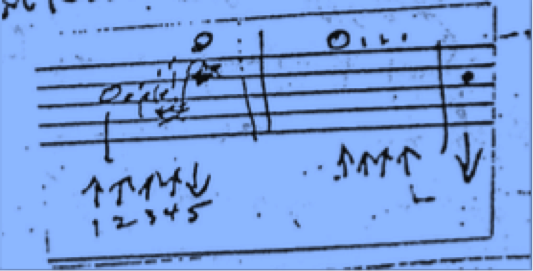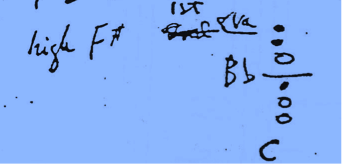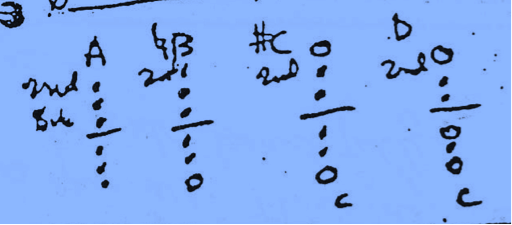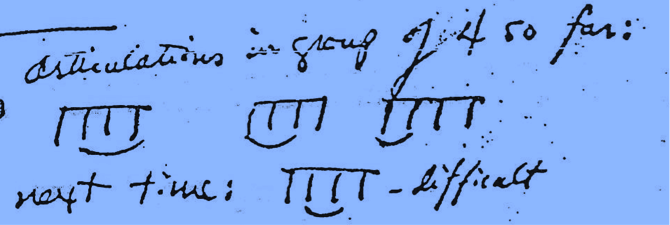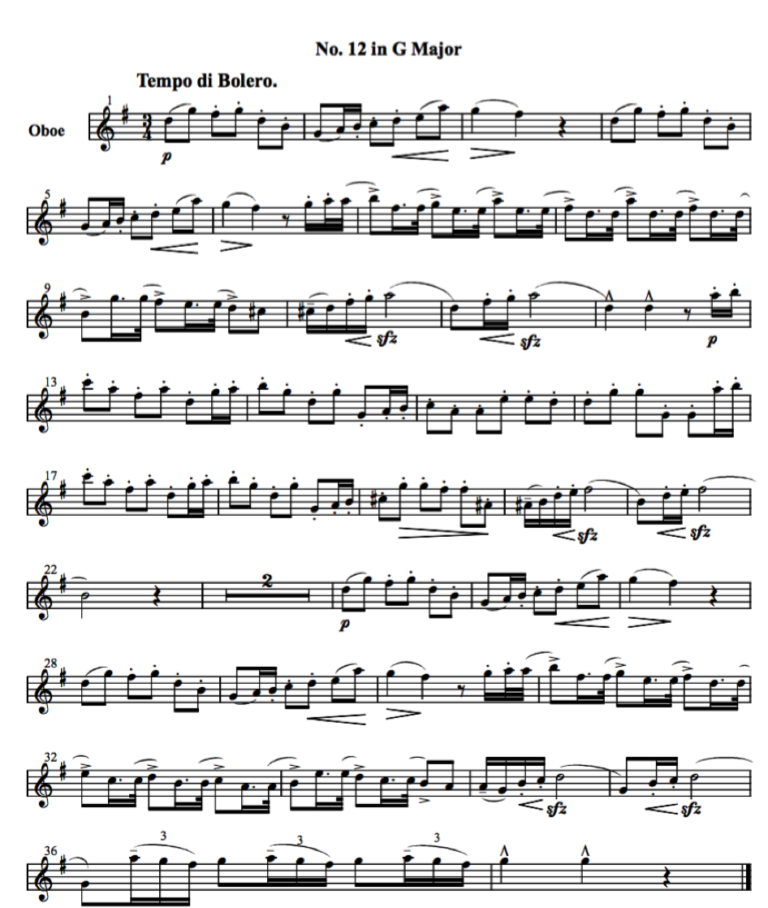Rowland Floyd (1937-2017) was the last student to study with Marcel Tabuteau. At the suggestion of his teacher, Marc Lifschey, Rowland traveled to Nice in late September of 1965 after Lifschey ascertained that Tabuteau would indeed teach him. Rowland spent the months of October through December absorbing Tabuteau’s ideas and taking detailed notes. After leaving Nice, he began his professional career, eventually winning the position of principal oboist of the National Arts Centre Orchestra of Canada (Ottawa). Rowland Floyd and Charles-David Lehrer worked closely together in preparing the following presentation about the Tabuteau System:
Rowland Floyd’s Notes Taken During Oboe Lessons
with Marcel Tabuteau: October-December 1965
Preface by Charles-David Lehrer
It has been some 52 years since the young oboist, Rowland Floyd, horn and reeds in tow, boarded a flight from San Francisco to Paris. His final destination: the apartment of Marcel Tabuteau in Nice.
Bright as can be, but still a neophyte, Rowland sought out the master during the fall and winter of 1965. Preserved in a small notebook from that time, one finds a plethora of information in shorthand, drawings, and musical notation entered during a series of nineteen lessons that Rowland had with Tabuteau. In fact, his text constitutes a rare look into a world, now lost forever, when the great teachers of Europe could take their students in hand and apply a kind of discipline which, in today’s world, is no longer in vogue. It is to Rowland’s credit that he survived his lessons with Tabuteau, persisting through a series of red-hot sessions until the untimely death of the master in early January 1966.
Within this rare look into Tabuteau’s studio, we find the great teacher at his finest: joking, scolding, and pronouncing a mountain of maxims as he puts young Rowland through his paces on the oboe. To be sure, Tabuteau’s unique insight into phrasing is fully present in these lessons — at its heart, his famous number system and motivic deconstruction methods. In addition, Tabuteau gives Rowland a look into the manner in which he scrapes a blank, and tunes the resulting reed.
Rowland went on to become principal oboist of the National Arts Centre Orchestra in Ottawa, Canada. So, dear reader, sit back and enjoy what few are still alive to remember: a series of oboe lessons with the incomparable Marcel Tabuteau!
Thousand Oaks, CA, February 2017
Realization of Rowland Floyd’s Notes by Charles-David Lehrer
Legend
T =Tabuteau
Tabuteau’s words are within quotations marks
The text without quotation marks or in parentheses is by Rowland Floyd
The text within brackets is by Charles-David Lehrer
Up and down inflections are indicated by letters (U and D) or by string rubrics:
up bow ![]() and down bow
and down bow ![]()
NB: Rowland Floyd’s notes taken during his lessons with Tabuteau were written rapidly and often abbreviated. I have expanded them into full sentences with Roland’s consent. All the musical examples have been converted into Finale, but the original diagrams have been retained. Those drawn by Tabuteau are noted. When there is text within the diagram, I sometimes added captions underneath to clarify what was written.
1st Lesson: Friday, October 8, 1965; 2:00-4:20 pm
At the beginning of this lesson, T said he had tried to contact me via telegram to come over just to get acquainted on this first occasion. (I noticed my note to him on his work table that I had sent earlier.)
“With whom did you first study?” I responded: “Laila Storch, Marc Lifschey, among others.”
“Did Lifschey like San Francisco? I was there at the time of the 1915 World Exposition; it was too foggy.”
T continued: “I practice every day.” And then he talked about his reeds: “You can see how I work. I made my first reeds at an engagement in Djon.”
T showed me one of his reeds and talked about balance. “Everything depends on the reed and the reed depends on the balance. It takes a long time for me to gouge.”
He looked at one of my reeds, a Richard Woodhams’ reed; he thought it too short and suggested otherwise. He crowed another one that squawked loudly; T grimaced.
I told him that the first three in my reed-case were better. He tried one: “It has a good octave crow.” (It was undercut with windows, had a short tip, and was rather short.) “It plays lovely but it is too limited. We need to be able to play out in a big hall.”
“I have a gamut [dynamic range] from level 1 to level 25, and furthermore, I can play the high-high C at level 25!” T mentioned that the high frequencies of the oboe complete the overtone series.
“Each note in an exercise or in a passage, even repeated notes, should be a different color and one should be able to undulate as a wave.” He did an amusing little Gypsy-dance with his eyes.
Then T demonstrated with his oboe. “There are many oboe players around, but herein is the difference: Like a billiard ball — one must direct the sound by way of phrasing; otherwise, it will go over the side of the pool table from being hit too hard. One can visualize this in the following example:”
Regarding the control of a phrase: “It is like butter in a pan, it melts, it runs; otherwise, it is like a rock in a hot pan. The notes of a phrase should be played on the wind in each direction, up and down, not as individual static notes.” [Rowland notates up & down arrows here].
“Don’t blow at the reed.” As I played he grimaced several times and shouted: “That’ your first trouble!” At this, T’s wife Louise came in and told him to be kind to me. She asked if I was able to take it, and T [!] said I was.
Laughing loudly, T told me to direct the air at my nose. He mentioned that in executing this, Lifschey used to make a loud noise; T mimicked Lifschey, laughing coarsely. “Most of my students have forgotten this maxim; they blow directly at the reed.”
I tried my reed dry at this point and noodled. T yelled “No! That is pointless! One must prepare, that is, support the tone before beginning – before attacking the reed.” Then he showed me noodling examples including the same notes I had played. Also, T played material I had played before in a loud raunchy tone — which is how I sounded by taking my instrument up and just playing unprepared.
T said he had his students count 3-2-1, or ready, play.
“If I don’t prepare, if I play at the reed abrupt and uncontrolled — it is as if I took a drink, gulping the liquid without preparing. Most of it would land in my face and go over my shoulder. Rather, one should proceed as one normally does in preparing to drink out of a glass.” T repeated this laughing quite loudly.
“Practice working with level 1 for next time, and for the following weeks. This sets the foundation, otherwise your playing will become unstable afterwards.”
Following are the formulas in increasing and decreasing the sound from level 1 that he presented to me:
1-2-3-2-1
1-2-3-4-3-2-1
1-2-3-4-5-4-3-2-1
and so forth.
And T was adamant that one must have a true level 1.
“All I have to teach is logic, first and last.”
Lesson: Reed construction
“The reed I recently made and your reed are both bad reeds; there is no such thing as a good reed. But I would choose my bad reed over your bad reed, since mine is more balanced. One way to see this is in the octave crow. Your top note in the crow is somewhat flat. This accounts for the stuffiness and limited quality in your reed.”
“There is no good reed. One must be able to play on any reed. The better the reed, the less work it is to play upon it. The concept of tone quality is in one’s mind (T pointed to his ear) and if you have to play on a bad reed, you work at it.” T showed this by mashing his lips together.
“Take more reed in your mouth, and turn, roll, and twist your reed in the oboe to the left as does a bassoonist because it lets the reed vibrate more.”
T illustrated degrees of lip pressure according to levels 1 through 5, etc. He put his hand on my arm. The most pressure he exerted was at level 1 (softest); he exerted less pressure arriving at no pressure, which is what an oboist does as he plays louder and vise versa.
“Take more reed in the mouth when playing low notes and loud notes. For these, you need more vibration of the reed.”
“When teaching, I always keeps something to myself; I never tell all, especially in America with conductors as they are. For example, Marc Lifschey was fired – the reason was that the conductors there did not appreciate him.” I said to myself, you (Lifschey) are a master colleague compared to the one they got to fill the remainder of that season.
“The breath is to an oboe player as the bow is to a violinist. Your reed still has a limited range for playing, the range being levels 1-5. A violinist is not great because of his left hand technique, but because of the work and concepts related to his right hand, which controls tone and color and gives variety. One must not just play in one place above the fingerboard – but all over – then each note has color. Often one must play ugly notes to bring out the beauty of others. If all notes are the same color, then it is boring.”
In one exercise (Barret Articulation Studies 1 or 2) T said attacca on the resolution note.
I did not understand what T was saying a couple of times and he yelled: “Stupid!” Conversely, he told his wife that I was going to make a good oboe player. To be sure, I’m nervous now about my playing, but I can make good reeds – and I have a good tone and a beautiful instrument. His wife, who came in only a couple of times briefly said: “With such a good Loree, you will make him (T) jealous. She asked what number my oboe was, if it was new, and remarked that Lorees are not supposed to be good these days and that I’m lucky to have such a good instrument.”
Concerning getting prepared – T told me: “Say ‘aaah’ and sustain this, then abruptly close your mouth with the pressure and support still there. Only then should you begin to play. You must always prepare for control. If you have the concept in your mind, especially concerning the reed and the tone too, then you can find a way to get it out.”
T said that he thought he could help me, but under one condition: “You must do exactly as I say. You must play levels 1-9 as a baby walking on soft legs. We could spend one lesson a week on reeds, the others on playing.”
Later, when I had difficulty comprehending a certain point, he said: “Never mind now – too many new ideas were coming at once.”
“You can never finish a reed on the same day. The cane does not like to be forced around that little hole in the staple. Adjustments will be necessary later on.”
2nd Lesson: Tuesday, October 12, 1965
“Say aaah and sustain this vowel while exhaling the wind; then think ready play. When I give the conductor’s downbeat, play middle D.”
“All notes are to be attacca [articulated], then all played legato; always at ppp (level 1). You must always perform these phrases with resolution, even in the slurred groups. The attack of each note, especially the first note, should not be dirty, but clear as when a thin-lipped glass is struck. A phrase has both interrogative and affirmative.”
Haydn: Surprise Symphony, 2nd Movement:
“Usually I decrescendo when I ascend. One must change the direction and color, et cetera, as the loop in my diagram demonstrates:”
“One should think of the natural direction of a brush (T used a feather gently against the wall to demonstrate). After the brush goes up and starts the direction downward, note the tip of the feather: it takes a moment to follow. This is the loop.”
Diagram by T:
T has a Marigaux bell on his Loree oboe. Plus he made alterations by hand on the bell for stability, clarity, pitch, and resonance on the lower notes.
“If level 1 is not down pat, including the attacks, then this is like building a house on a shaky foundation.”
T advised me to play on a reed by itself, or in tube of cane to ‘save’ the neighbors when practicing.
“Adding to the example of the loop and brush-stroke idea — think of an athlete chinning on a bar: When he lifts his arms up, and chins himself up, he can go only to the chin position. If he would like to go higher, then he must make a transition – his arms push him up and above:”
This transitional stage (2 to 3 in the illustrations) is the loop or change in brush stroke.
T directed me to draw my lower lip more over my lower teeth and lay the reed against my lower lip. He showed how Robert Bloom went to an extreme since he held the oboe almost flat against his chest. T said that this was almost like he was playing with the oboe in his behind! T said Lifschey was extreme in the amount and direction of the air he aimed at his nose [upper palette] resulting in noise. T imitated both!
The point being: Don’t hold the oboe out at such a straight angle. T demonstrated, showing how uncontrolled and wild the sound is — actually barbaric. I noticed that T had a crease, a red mark on his lower lip after playing, which was ¾ of an inch long where his reed impressed his lip by turning it slightly to the left.
“When I was not feeling well in the Philadelphia Orchestra, I could play anyway because I had teledirection [telekinesis], a mental concept which took over.”
3rd Lesson: Friday, October 15, 1965
“Keep your fingers curved, especially your right-hand fingers” which I had been holding straight and not over the keys. “If you continue in this way, you will not be prepared to finger quickly.”
T said that my attacks were better.
I doodled a passage. T was annoyed that I could not remember it after several attempts. This occurred with the aforementioned finger position problems. “It would be more difficult for you to undo bad habits then to learn new ideas.”
I played several scales at level 1, two octaves each. T asked for the same in 3rds.
My assignment:
- C major scale on level 1 to high F — two octaves and articulated
- A minor scale likewise
- Levels 1 – 9 – 1 on the same note (an A) and in the combination A – B2- A, tongued and slurred, carefully observing pitch and dynamics:
In addition:
- D♭ major scale on level 1
- B♭ minor scale on level 1
- Chromatic scale: Low C to high E on level 1 and return. Note that levels 1-9 and 1-5 must return back to level 1
- Make up pitches to fit the following pattern [a scale]:
1122|3456|7 7654|3432|1 (question and answer phrases).
He told me to play the above pattern as follows: a) detached; b) slurred. “In each case group the pitches together. Think: interrogative, affirmative (i.e. question, answer).”
“In a scale of 2 octaves, breath only after a down impulse. For example:”
“This is the answer to breathing in Bach: Catch a breath on the fly as would a frog, otherwise you will not get the fly.”
“In any exercise, prepare by exhaling the air saying Ahhh…; also end on level 1 for example, 1234|5432|1. When articulating, strive for a long sustained last note on level 1, decrescendo, then lightly touch 0.”
“In playing intervals, change with the brush stroke. There is a slight moment to change. One must change exactly as a feather’s brush-stroke with its follow-up.”
“Don’t puff out your cheeks; imitate me.”
“Look straight ahead at me, the conductor; don’t look at the ground.”
“Hold the oboe straight, not to side of the mouth as flute player.”
“Make your attacks clear, like the ring of a good glass goblet.”
4th Lesson: Tuesday, October 19, 1965
“Always test the reed itself, then the reed on a tube of cane prior to putting it on the oboe.”
“When playing scales, for sake of practice and to meet physical demands musically, breathe after every 9th note. For example:”
“The breath mark occurs after a down-beat, and is musically not disturbing as it would be before the final note of the scale – the D♭ in measure 2.”
“The pattern for the above is verbalized as levels 1-9, alternating down and up: 1234|5678(ex-)|9(hale) breathe 876|5432|1.”
“The breath should be quick, that is, on the fly, and the attack afterwards should be as nearly as is possible like the note before it in intensity and dynamics.”
“The chromatic scale also should be scaled in groups of nines.”
T said I had the obligation to become a new man. At present I am like a gangster with bad habits. He, T, is the doctor who will change my face.
“A beautiful tone, in and of itself, is not more useful than having a fine rifle and not being able to aim it in the right direction. My Teledirection is mentally guided.”
“Even so, if a man has great and noble thoughts but lacks the where-with-all or the technique to write them down, then he is not much use to the world as a philosopher”.
T speaks in terms of aiming the rifle; of shooting tones into the audible.
He mentioned previously his concept of sound — giving it color and comparing it to the French sound which is like a straight line. But T colors it such a way that a straight line becomes a circle. He demonstrated by bending a piece of straight cardboard.
“Playing on a hard reed is like sitting on a hard chair: One might as well be comfortable.”
For the example above [D♭-major scale], I must color the tone. T speaks of one-way traffic, i.e. the lack of color, the lack of variety, the lack of intensity, and the lack of direction. In essence, the lack of the ability to shoot, i.e. the lack of concept and the ability to express that concept.
“I think that the oboe is nearest to the human voice in being able to express ideas of warmth, et cetera, or whatever one wants.”
Many misunderstand what T means in his numbering system. His numbers refer to:
- speed
- direction
- groupings
- scale
“Regarding the oboe’s sound, the head sound versus chest sound is like the register factor in the human voice: The head voice to the chest voice, and back to the head voice, is 1 to 5 and 5 to 1. The chest voice to the head voice, and back to the chest voice, is 5 to 1 and 1 to 5.”
“A big tone is only a dolce tone enlarged. The dolce tone is the one nearest to number one.”
“Strive to concentrate on everything one does.” (Implication: Ramifications to the ability to learn how to shoot in music.)
“Let the sound ring in your head before actually playing. Know what you are doing before playing. For this reason, mark on the music itself, the places one intends to breathe.”
“Prepare the wind pressure. The device of saying ‘Ahh…’ prior to playing is intended for this purpose. Compare this to the fact that pressure exists in a water faucet before one turns it on.”
“That is, don’t let the pitch or the support fall; keep the pressure up, keep the direction up.”
“Use violinistic bow-marks for marking phrases with up and down beats — it is easier to read. Each week bring a short passage marked in phrase numbers, plus up and down beats.”
[Rowland’s ![]() and
and ![]() markings represent up and down inflections and not actual bowings.]
markings represent up and down inflections and not actual bowings.]
Assignment: Scales of D, E♭, and E major.
- Mark the breathing spots
- Remember to say exhale
- Continue at the same level
5th Lesson: Friday, October 22, 1965
“Don’t be discouraged. I once played by sight, and without rehearsal, the opera Aida under Toscanini at New York’s Metropolitan Opera, and on a bad reed which I had just made.”
My discouragement at this point shows that T’s ideas are beginning to work. T said: “You are a villain coming in for a face-lift [face-change] and I am the the doctor [plastic surgeon].”
“Practice scales using only 5-1 and 1-5. The landing and the takeoff: These constitute the hardest part, as in flying an airplane; so it is in playing a scale.”
“Use a mirror to check against a cheek or cheeks puffing out. Also, check to see that the oboe remains straight down, not to the right side. Check to see that the embouchure is flexible: up-and-down with the range of the instrument; in other words, in-and-out of the mouth by degrees.” (T demonstrated pushing down with the left hand.)
“Practice on the reed alone, and then insert it into a piece of cane. Play chromatically using levels 1 to 5 to 1. Before playing, try the reed in the embouchure alone. The reed should be further into the mouth for high notes and further out of the mouth for the lowest notes.”
“Also use a mirror to see that when tonguing (attacking each note of a scale) that this is done on the wind and not separately. Maintain the air pressure at all times, and in tonguing, no exterior movement should be seen. Check incidentally to see that you are sitting up straight with your feet on the floor to insure proper support. If individual movements in the throat can be seen, this means that the air pressure starts and stops on each note during tonguing. This is wrong.”
“In practicing a 5-1 scale (whether slurred or not), remember to keep the air pressure constant, the dynamics, the attack on 1 to 0, and the landing.”
“Also the pulse in the 5-1 scale is:”
“Level 1 attacked and sustained, followed by touching 0, gives the following effect:”
“That is, the air spins:”
“Change as in the loop –- at exactly the right time.”
“Bring a preceding tone (during an interval change) to the level of the up-coming note. This is illustrated on the oboe as below:”
[The figure on the left appears to be demonstrating upwards pressure of the right hand. The figure on the right is an enigma.]
6th Lesson: Tuesday, October 26, 1965
One takes an inoculation against typhoid, thus so, T’s teaching is an inoculation against stupidity (so he says).
“A brush stroke is like an inhale, exhale in natural breathing — both are necessary. Just so in music. If one just painted all the time in music without observing the change in brush strokes, then the performance would be dull.”
“The most beautiful interval is the one (in ascending) where a decrescendo is made to the higher note. Thus:”
“Pianiss-iss-iss-iss-issimo is not all on zero (0); that equals death. Even at the lowest dynamic level, there must be some direction. The same inner work must be applied as if the passage were double forte; for example:”
In the above passage, if played properly, the F# should usually be played louder and stronger than the A which is the higher note.
“Mark the brush [up and down impulses] in the following Haydn Symphony excerpt:”
When I asked which of the two excerpts above is better, T said: “It is a matter of choice; I would choose the latter. The difference is the same as between the tempo [movement] of a horse – one which trots and one which gallops. A jockey rides not each individual step of horse, but the up-and-down movement as a whole.”
For same reason, T plays the opening to Beethoven’s 5th Symphony as follows:
“The first example is for show rather than for music.”
“Only Artúr Nikish conducted Beethoven’s Symphony Number Five from this proper rhythmical standpoint.” (recorded)
(Continuing the discussion of the Haydn example): “When proceeding faster, the change is between the the 2nd and 3rd eighth notes.”
“But not, for example:”
“Thus: Example B is my first choice, A my second choice, and C the worst choice.”
“For scales: always play detached first, then slurred – two octaves each.”
“When playing a scale, the following five points are included in my Concept of Scaling (scaling related to distribution):
- The reed position is scaled, in other words:
- One must have more reed in or out of the mouth depending upon whether one is playing the high or low part of the scale.
- The amount of pressure on the lips is determined by the inverse proportion of lip pressure to intensity.
- The wind is scaled
- The space is scaled (- — — —-)
- The number is scaled as to intensity, in other words, if its to be 1-9-1 or all 1.
- The pitches of a scale are scaled.”
“Before playing a scale:
- Feel the belt or abdomen before attacking; in other words, ascertain that a full amount of pressure is present before starting, not afterwards or even simultaneously.
- Find the correct place on the reed. That is, each reed, however less than perfect it might be, has a right place for each note of the scale. This has to do with putting more or less of the reed into the mouth in a flexible manner. By playing a note a 3rd away, for example low D above low B♭, one can determine where to place reed for low B♭.
- Always touch the first note, and also always touch last note; in other words:
- Teleguide all of your distribution in scales and otherwise. Don’t just play. Know beforehand what you are going to do.”
[The Guidonian Hand]
[The Tabuteaunian Hand]
Example of hand. Up and down 5 counts, 2 each (i.e. up and down) (or rebound) = 10 note scale.
The Rebound: “This is the same pitch note repeated, but played differently. In the following symphony excerpts, one must practice the individual second note as a rebound from the preceding note:”
In the following example, T used a micrometer turned in or out to demonstrate the basic core of sound from the lowest to the highest range of the instrument.
“Attach a strong rubber band to the wall. No matter where one goes or how tight the stretch, it is still part of the same core, the entire gamut: high to low, loud to soft.”
“Another use of the word ‘loop’ is a figure 8. My teacher, Georges Gillet, made me play phrases on the figure 8. I asked him how this worked, and Gillet said that each phrase could be found to fit. Phrases are, thus, not just up to down and up to down, but also up to down and down to up:”
“For example:”
“The following are exercises in distribution: Practice first with one note only; then when you have that aspect of the technique of distribution, change the notes.”
Madama Butterfly theme:
[Oboe part from full score provided by Charles-David Lehrer]
“Here is how to play the interval of a 3rd from low to high: Slur the distribution chromatically. On the oboe, the effect following a crescendo of the initial note, will be a piano on the arrival note a 3rd higher.”
“Playing from low to high, one does not have to pronounce the high note because it is already pronounced in preparation. Pronounce no more than you would the letter ‘k’ in knife. It is the same when playing from high to low.”
“One must teleguide the distribution. Projection, et cetera, is not from the reed, but from thinking; in other words, the little machine does the projecting.” (T pointed to his head.)
“My teacher made me touch the dot on dotted notes, then slur the notes, indicating where the brush stroke change occurs. The brush stroke changes here,* as in the passage from Daphnis:”
“Electricity must have the friction of positive (+) and negative (-). So it is in music. There must be the stupidity of a metronome, or conductor, against the intellect or inner beauty; in other words, phrasing must be work against the negative of the printed-music barline, and within it.”
“The negative in music as like the negative of a photo. The color and what we do with the line ourselves is the positive. A conductor who spends his time only memorizing the score is thus steeping himself in only the negative.”
“I learn something every day from the knowledge I have. If I cannot learn from what I know already, then it is not worth knowing. That is the philosopher in me that is speaking.”
7th Lesson: Friday, October 29, 1965
1st lesson of this day
After I offered to pay T before the lesson, he said: “Only with a prostitute do you pay before. This is music!” (I paid 488 francs for the first 8 lessons).
“You have a lack of discipline.”
“Scales are all-important. Strive to make them beautiful. Give more emphasis to the up and down on each group of 4 notes:”
“Also in scales, strive to have the note following an ex-hale maintain the same intensity level as the preceding note. There is a tendency to have this note weak.”
“Within a 2/4 measure, no connection please between | quarter, 8th, 8th | quarter, 8th, 8th | quarter.
There is, however, connection in the combination (No. 1): |8th, 8th, quarter | 8th, 8th, quarter |.”
Scales:
1st: Two octaves staccato.
2nd: Two octaves legato.
N.B.: Breathing ex-hales, scaling everything, and making the length of notes different equals a beautiful scale.
“When playing minor scales, use the harmonic minor because the augmented 2nd gives a flavor that melodic minor doesn’t. For example in C minor: A♭ (6) to B natural (7) , to C (1).”
2nd lesson of this day
The oboe plays on higher pressure than the flute. To regulate and concentrate on maintaining pressure for use in daily scales, exercises, and forthcoming passages, I tried spending time in all-legato playing and softer dynamics with the greatest amount of pressure possible. This seems necessary in order to get the gax, fah etc. out of my attacks, which I apparently employed as a substitute for lack of pressure. Also this helps the notes to respond.
The reed, as well as the instrument, is actually in the head (in other words, a concept). Thus says T: “A reed or oboe is never perfect; but in greater or lesser degree, it helps produce the concept.”
I played part of a faster Bach aria: Wedding Cantata BWV 202 [Score provided by Charles David Lehrer]:
T circled the note A as a rebound; this is as the Brahms and Beethoven examples in a previous lesson.
“Don’t start the phrase with too much force. As gears in a car, start in low gear.” (Previously T used the example of a locomotive starting up and gaining in momentum.)
“In an aria, such as the one in the Wedding Cantata, only subtle inflection is needed. There is no need to blast.”
“A good tone is a great help — perhaps 60% of good oboe playing, but one must learn to direct it.”
“To see what passages dictate (there are often several possibilities), write out the groupings and bring this to the lesson. Also bring Barret. If you learn Barret, then regarding the oboe you will know enough. Anything I could say more would but end in such a method book, but not take its place or compete.”
From an earlier lesson: “Note the change from
done by this secret: air pressure. This is done like bicycle pump pressure. Simultaneously with a loop, remember the bar bell. From D’ to D apply the concept.” T used his arm as an example.
T used the example of a flame: ” Blow softly at it and it bends. It’s more difficult bringing it back up which requires more control.”
8th Lesson: November 2, 1965
“This a good daily exercise in the key of the scales being practiced:”
“This is to be your scale pattern: 1 to 5 to 1; then scale two octaves, always touching 1; scale everything. Afterwards, play the following exercise both articulated and slurred:”
“As in the numbers on the board at a stock exchange, all changes are made gradually. Don’t increase from 1 to 20 with one leap and bound. Connect!”
I noted that T increases; it is not big, but faster (with the air spinning).
“Quality goes through the orchestra; it penetrates. Don’t play too loud.”
Barret: 12 Articulation Exercises
Examples provided by Charles-David Lehrer
from the IDRS On-line Edition
“Note especially where the line is going. The highest note is not always the climax, that is to say, in the first measure. Also, the first measure ends on the first 16th in the next bar, not at end of first bar.”
“This is the articulation to be used in the 2nd measure:”
“In the last two measures, the high C is less than the following high A. Note the last two beats:”
“Also prepare the 2nd articulation exercise for the next lesson.”
[Continuing this lesson]
Barret: 40 Progressive Melodies
Examples provided by Charles-David Lehrer
from the IDRS On-line Edition
“In the extension of the 4th measure, do not pronounce the E greater than the F. It should be in line with the decrescendo.”
“Regarding the length of the sixteenth note in the 4th measure. Take note as follows:”
“In the measure after the double bar, treat the 4 eighth notes as an extension into the next measure.”
“The diminuendo should be observed in the 3rd measure after the double bar, but note the up inflections:”
“Before the appoggiatura, make a slight pause:”
“On the 8th measure after the double bar, no rubato:”
“In the last 4 measures: Punctuate after each of these. They are not on speaking terms:”
“Repeat the above study transposed to D♭ and prepare the 2nd study for the next lesson.”
T said the following:
“Don’t let your mediocrity come to the top; but just the cream, like in milk.”
“The more you intellectually learn about music, the less you know.”
“If my theories were not true and sound, I could not do today what I do. Others fail at a much earlier age.”
“Remember:
The control of the wind.
Tongue-ti is sharper than ta.
The new version of ex-hale, breathe:”
Conducting
Actual Count: 1, 2, 3, 4, 5, 6, 7 = ex-, 8 = hale | 1 = play
T’s count: 8, 1, 2, 3, 4, 5, 6 = ex-, 7 = hale| 8 = play
T said: “This new version helps maintain evenness before and after breathing.”
The following 11 lessons
in November and December
of 1965
were undated
Lesson 1
T gave me this assignment: “Practice the A♭ major scale to high F, scaling as follows:”
“Keep working on scaling the length of the notes and the space between them. This, plus the coloring, is the most difficult thing to do. Play scales every day. This will force you to make your reeds better; this is the nurture key.”
“I never play any four notes the same length, that is, any four notes in succession. This is the Tabuteau System.”
Example by T:
“In grouping, often the fact of thinking is sufficient. Don’t overdo it.”
“A big tone in and of itself does not carry. Like the woman without the girdle, everything spreads.”
“In the word ready (rea-dy), the natural accent is on the first syllable. It is as natural as breathing, it’s not a matter of volume.”
“The speed of wind must be sharp as a razor.”
“Reeds are best with the least vibrations; when made this way they present fewer problems.”
“Color is the life of the note.”
“Like a violinist changing the bow, the main thing is the up and down bows (inflections):”
Additional assignment: B♭ major scale to high F.
“Use this fingering for the high D:
“And for high C♯:
“Remember to articulate the wind.”
“Just as when when you whistle, three times more wind speed is required in preparation to play the octave (third octave) on the oboe.”
“Remember: Down-Up equals question, and Up-Down equals answer.”
T spoke of going to ‘shine up’ a certain pupil [teach him a secret] in order to go after another, when the latter gets cocky.
Lesson 2
T gave me this assignment: “Practice the B♭ major scale articulated then slurred. Use the full length of the bow at 9: 1 to 9 to 1.”
Diagram by T:
“On the violin, the area from the finger board to the bridge constitutes color change as follows: 1-25-1. On the oboe, push the reed into the mouth further as you ‘reach the bridge’ in order to change the color of the sound.”
Diagram by T:
………………
Always give the man in front of you (the conductor) the feeling that you admire him. Therefore, keep your head and eyes up!”
Exasperated, T said to me at this point: “I drink the whiskey, but you are the one who is drunk!”
“When scaling 5 to 1: In order to help get to level 1 when it is to be played on a low note, proceed as follows:”
“In performing the 1 plus 3 articulation combination, note that it is not one-detached, three-slurred, but in reality, two-detached, two-slurred.”
Tonguing: ta = up; ti = down
“There is always a reason for everything. There is one reason why you make it, and fifty why you don’t make it.”
“Use numbers both for grouping and for distribution.”
Lesson 3
“Never breathe while playing in highest region of a scale.”
“In the 1 plus 3 articulation combination, utilize D (short) and U (syncope).”
“Never take a breath between an up and a down, especially before the last note of a scale (re-solve), or you will receive Capital Punishment!”
“Begin increasing the velocity of your scales every two weeks, eventually reaching mm = 120 and playing them as follows: detached, slurred, and articulated.”
T’s maxim: “Don’t articulate with wind, but articulate the wind.”
Two types of ti-long: A and B; diagram by T:
Lesson 4
“When you start the car, you start in zero, then gears 1, 2 et cetera. Do not begin in high gear.”
“Play softly, for Lord’s sake!”
T’s Diploma of Stupidity: “The faster you go, the more stupid you become! Also, the louder you play, the less volume.”
“Think O on a low attack, not E like a crocodile. Then you are cooked.”
“Hammer with the fingers when playing the oboe; like a pianist, curve your fingers, do not hold them out flat.”
“A tone is originated from the floor up.”
“Solid to liquid: Like butter in a hot pan the solid melts diffusing the color. In other words, it diminishes like the smoke of a good cigar: At the end of a phrase it goes up.”
“Playing is a reflection of how you are thinking. I teach to think beautifully.”
“Blow under a note, not on top of it. Like a balloon which equals a note, keep hitting it to keep it in the air.”
Articulation; diagram by T:
*Shorter than the preceding accented note.
“This is singing your articulations.”
………………
“Return as a yo-yo. Make the wind return. Get a yo-yo and observe.”
English Horn passage in the New World Symphony:
“The trick is to play the dot. My teacher made me touch each dot.”
a) “Note that the wind on a dot:
is not the same as:”
b) “Then slur as a yo-yo.” [New World Symphony English horn passage.]
………………
A tonguing exercise:
Lesson 5
“Breathe between two ups, but never between up and down.”
“Take ‘ti-long ta’ as one group. Play the first ‘ta’ on the length of ‘long’. Sing your articulations.”
“At Curtis I was the boxer who punched my students for 4 years.”
“Always prepare before starting to play. Otherwise you bark like a dog.”
“In playing intervals: To go down, one must first go up. Otherwise it is like having your feet on the ground and trying to go lower.”
“Scale your levels 1-9 et cetera on the embouchure and space, not on volume. Then the quality will carry. Volume will not.”
“Between two ta’s, the neck must not collapse.”
Lesson 6
“Numbers also can be used to indicate the distance from the fingerboard to the bridge. More bow, equaling intensity, is gradually needed while proceeding from levels 1 to 10, which, in turn, equals a different set of colors.”
“Relax during breathing, just as it is necessary in swimming. Otherwise, if you are stiff, you will drown.”
“Push on the last note before the breath,* exaggerating and overemphasizing it to learn. Later you can balance it up.”
Intervals [Diagram by T]: “Mentally, fill it in. This is the singing interval.”
“My teacher, watched a bottle blower. The shape was made by blowing in and out. Never was a square produced. Likewise, one must shape phrasing with the wind.”
“A conductor once told me to play like an organ. So I did, clipping the notes. The organ is not able to play in-between the notes, but always on a straight line, rather than as a circle.”
“Regarding the breath, the emphasis is on playing on a low amount of breath. When you inhale, also exhale. Do not play on a full inhale.”
“Russians are good musicians for three reasons: There is dance in their music; they sing their music; they respire, that is, they breathe — take a breath — and are alive. Russians have discipline, teleguide. I am Tabuteau, the Russian!”
Lesson 7
“To make a musical line sing means to push the pivoted note. Just like climbing the rungs of ladder, don’t put your foot in between.”
“Most of my pupils only imitate without understanding.”
“Use the metronome to practice articulations. It’s good to be stupid sometimes.” (The metronome equals stupidity).
“Put more weight on ‘solve’ than on ‘Re-‘ both in chromatic situations and in dotted combinations, for example:”
“Scale your tone when you start to play. Save the big tone. In stringing pearls for a necklace, one doesn’t put the largest pearl in the back. In every group, there is a pearl somewhere. It’s up to the player to decide where.”
T told me that he did not teach others to play like him, but like themselves.
Lesson 8
“Up-down is like a two-stage rocket; but when down-down, two ups always follow:”
Romeo and Juliette:
“Leopold Stokowski was the master of the up-down, but not down-up.”
“There is no such thing as a good reed, just a reed less bad than others.”
Regarding playing certain notes: “Don’t play them as an empty eggshell bouncing on water, but as a balloon bounced and kept in the air.”
“In vino veritas, in veritas vino. Take that down, young man.”
“Playing pianissimo is not next to zero alone, but implies playing with direction and inflection.”
“Be against your mediocrity as much as you can.”
“Scaling is as like a necklace: every note is a pearl. You must put them into the necklace. Otherwise, no one will buy your necklace. “
“Don’t be a duck that flaps its wings. Glide, use pressure, use the wind of a bagpipe.”
“The following is an exercise to test the range of the instrument and to test the reed, tongued and slurred:”
Lesson 9
The following is a new pattern T presented to me:
“Even on the same note, emphasis can determine whether it is interrogative or affirmative:”
“The musician who can only name chords is like the grammarian who can name parts of speech but cannot say anything. Naming chords is concerned only with the vertical. I am the expert in the horizontal.”
T’s harmonic fingerings for one of the Tchaikovsky Concertos:
According to T this is the Tabuteau Coat of Arms:
- Paint Brush
- Fork (one plays in-between the tines)
- Micrometer
“There are two ways to learn: From people who show you what to do, and from people who show you what not to do. I learned this from my students.”
As an example of how phrasing works, T’s teacher told him to watch how an elephant feeds himself:
Start of the phrase: “See the turn of the snout as the elephant puts food into his mouth.”
End of the phrase: “A good phrase ending is like the smoke of a good cigar going upwards.”
Lesson 10
“Indian (meaning Hindu) dancers hold their arms out to the side, and move their wrists gracefully. So do I when playing, as I do it on the wind: I glide — I keep a balloon in the air by pushing it upwards.”
“It is necessary to scale even when you articulate a scale. Again, when you scale the space between notes, you automatically scale their length.”
” For example, on the same, note proceed as follows:”
“One may ask: Why not return to level 1 in the answer part of phrase? If one did, the answer would be doubtful. The distribution number is, therefore, just as important as the tonal strength.”
“The speed of the wind carries as sharp as a razor.”
Lesson 11
T disliked the inability of the organ to play between the notes. Regarding that, he said: “Toot-a toot-a; the organ shuts the wind.”
The following is an exercise by T for any series of chromatic groupings:
“There are two types of intervals: singing and extension. Therefore, in the following Barret study, don’t ‘pronounce’ the first to the second note, as it is merely an extension of the first.”
[T left Rowland with the following sage advice:]
“You are in command. Don’t let the oboe be in command.”
“A bird sometimes flaps its wings against the wind to fly. Other times it glides. It is the same on a sustained note.”
“Play scales and articulations every day, 30 to 45 minutes each. It takes a lifetime.”
“Discipline yourself, just as if I were with you to tell you what to do all the time.”



